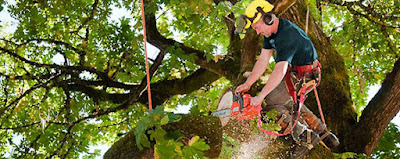How Can an Arborist Help Save Your Trees from Disease?
Trees are not only beautiful and majestic, but they also provide us with numerous benefits. From purifying the air we breathe to providing shade on hot summer days, trees play a vital role in our environment and well-being. However, just like us, trees can also fall victim to diseases that can have devastating consequences. That's where arborist services in Melbourne come in.
Let's explore how these tree care experts can help save your trees from disease and ensure their continued vitality.
Understanding the Importance of Tree Health
Healthy trees provide us with a myriad of benefits. They improve air quality by absorbing pollutants and releasing oxygen. Trees also act as natural air conditioners, reducing the temperature in urban areas and mitigating the effects of climate change. Moreover, trees provide habitat and food for various wildlife, enhancing biodiversity. They also prevent soil erosion, filter water, and contribute to the overall aesthetics of our surroundings. In short, healthy trees are vital for our environment, health, and well-being.
On the other hand, tree diseases can have a profound impact on both the individual tree and the ecosystem as a whole. Tree diseases can weaken the tree's immune system, making it more susceptible to stress factors such as pests, drought, and extreme weather conditions. This can result in reduced growth, leaf loss, and ultimately, tree death. Additionally, diseases can spread from tree to tree, affecting entire forests or urban green spaces. The loss of trees due to disease can have devastating ecological and economic consequences. That's why it is crucial to take proactive measures to prevent and treat tree diseases.
Identifying Common Tree Diseases
To effectively combat tree diseases, it is essential to be able to identify the common culprits. Some prevalent tree diseases include Dutch elm disease, oak wilt, chestnut blight, and various fungal infections. Each disease presents different symptoms, but some common signs to look out for include wilting or yellowing leaves, premature leaf drop, cankers, and abnormal growth patterns. If you notice any of these symptoms in your trees, it's time to call in the professionals.
The Role of an Arborist in Disease Prevention
Arborists play a crucial role in preventing and managing tree diseases. With their expertise and knowledge, they can identify the early signs of diseases and take appropriate action to mitigate their impact.
Let's explore how arborists carry out disease prevention measures.
Conducting Professional Tree Inspections
One of the primary roles of an arborist Melbourne is to conduct thorough tree inspections. Arborists are trained to identify signs of diseases that may go unnoticed to the untrained eye. They have an in-depth understanding of tree biology and can recognise the subtle changes in the tree's structure, foliage, and overall health that may indicate the presence of a disease. By identifying diseases at an early stage, arborists can implement timely intervention strategies to prevent their spread and save the affected tree.
Implementing Proper Tree Care Practices
Arborists also play a vital role in implementing proper tree care practices that promote tree vitality and prevent disease. Pruning is an essential technique used by arborists to remove dead or infected branches, improving air circulation and reducing the risk of disease spread. Proper pruning techniques also help trees maintain a balanced structure, reducing the likelihood of branch breakage during storms or high winds.
Soil management and nutrition are another critical aspect of tree care. Arborists can assess the soil quality and recommend appropriate measures to enhance nutrient availability and water retention. By ensuring optimal soil conditions, arborists help trees develop strong root systems, improving their ability to fight off diseases and withstand environmental stressors.
Treating Tree Diseases with Arborist Expertise
In some cases, despite the best preventive measures, trees may succumb to diseases. When that happens, arborists have a range of treatment options at their disposal. The most effective treatment approach depends on the specific disease and its severity. Arborists may use targeted pesticide applications to control pests that are contributing to the disease, or they may prescribe specific fungicides to combat fungal infections. However, it is important to note that arborists prioritise the use of organic and environmentally friendly treatment methods whenever possible to minimise harm to beneficial insects, animals, and the surrounding ecosystem.
Arborists may also recommend cultural practices to support tree recovery and boost its natural defenses. These practices may include adjusting irrigation schedules, improving soil conditions, or implementing companion planting strategies to deter pests naturally. By combining their expertise with these holistic treatment approaches, arborists can help save diseased trees and restore their vitality.
Conclusion
In conclusion, arborists are the unsung heroes of tree health. Their expertise, knowledge, and dedication to preserving and protecting trees from diseases are invaluable. By conducting professional tree inspections, implementing proper tree care practices, and offering effective treatment options, arborist Melbourne play a vital role in saving trees from the brink of disease-induced demise.
.jpg)
.jpg)


Comments
Post a Comment